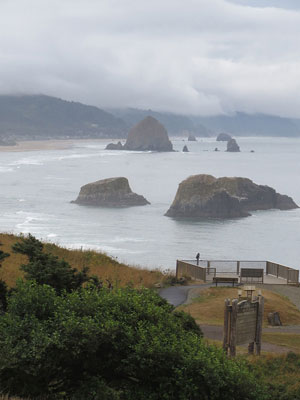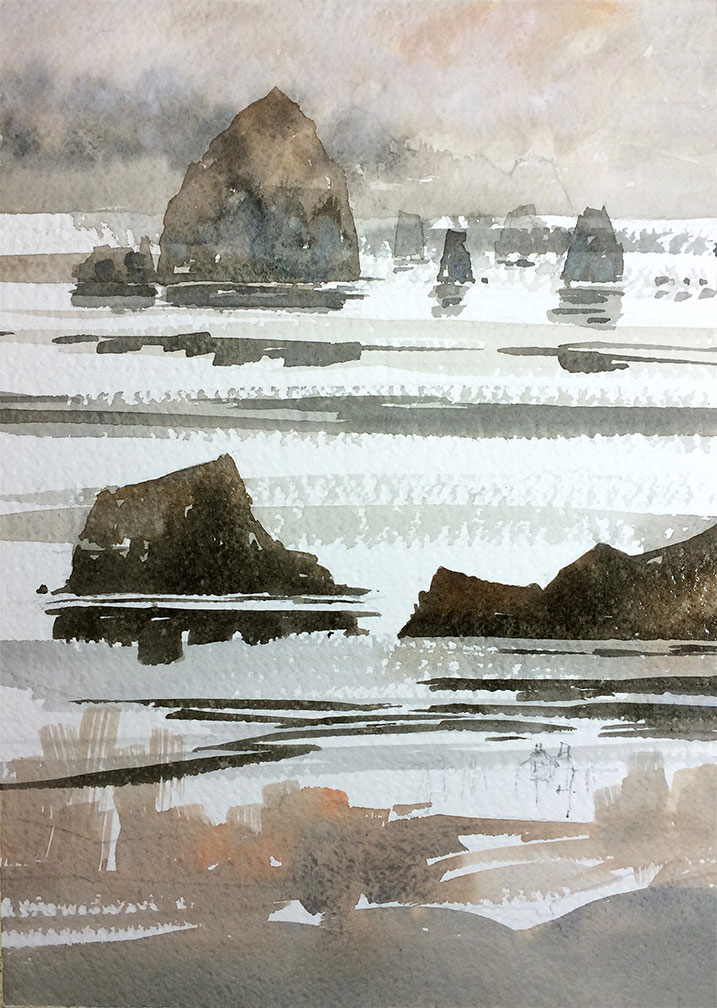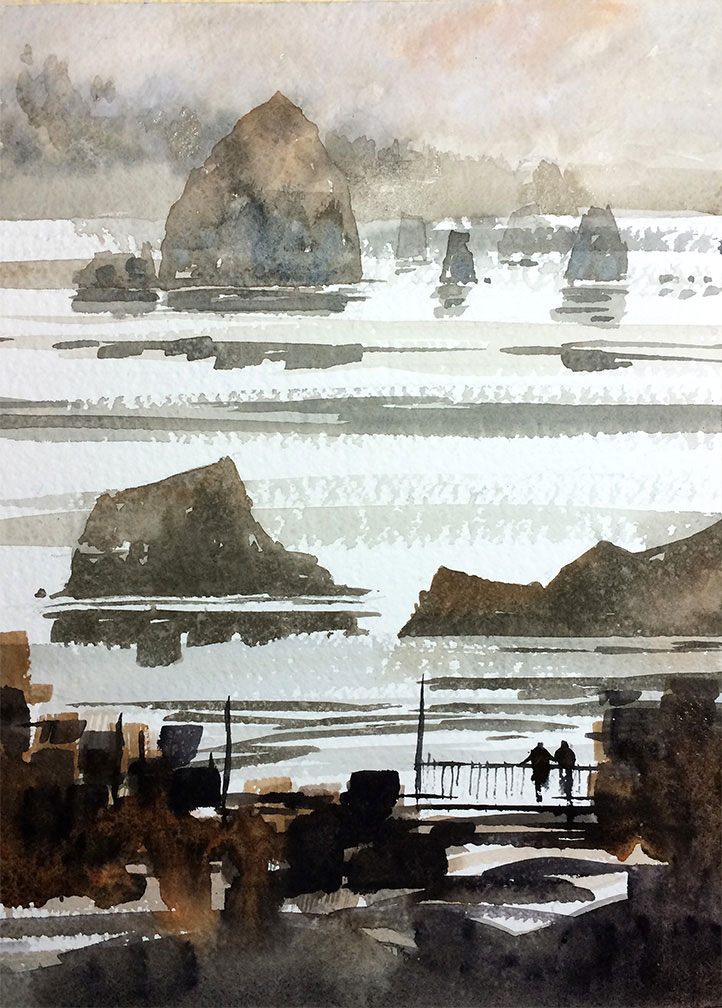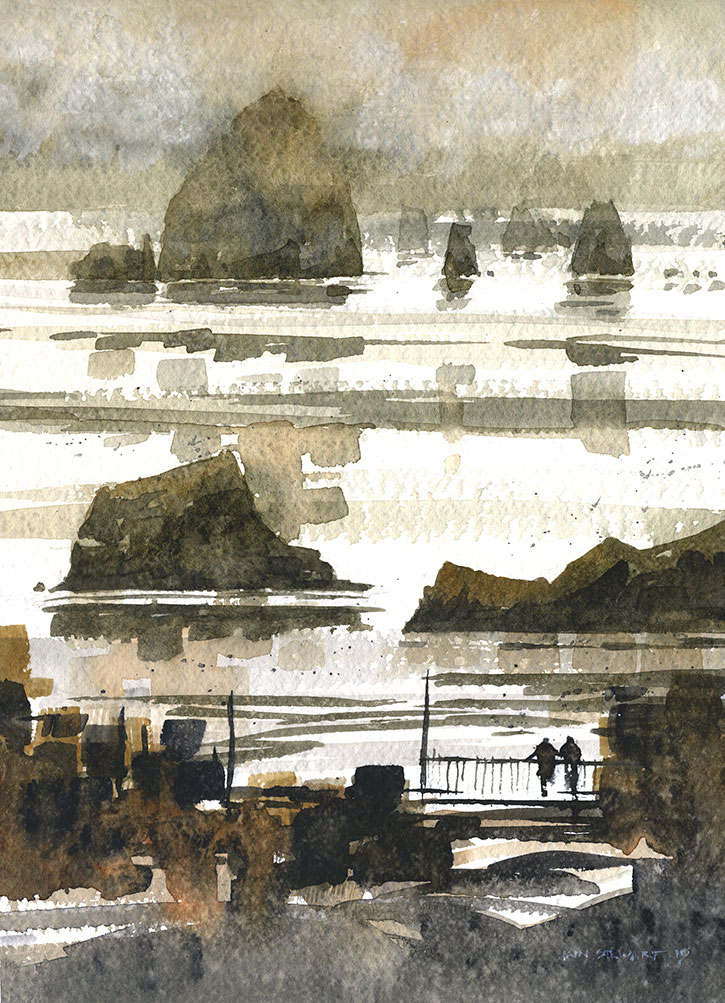Share:
I recently returned from a workshop tour including Alaska and Oregon. In my workshops I find that one of the most difficult techniques to grasp is the use of connected shapes and value. A few years ago I started all my workshops with a Neutral Tint value study and that gradually evolved in to my graphite value/composition studies I do before most of my paintings.
In Oregon I decided to go back to a semi monochromatic watercolor demonstration so that the students would see the direct correlation between the set-up sketch, and the mental and written notes on how to edit the subject down to its essence without the added temptation of color. In my paintings I rarely let accuracy trump good composition and free myself to edit and move objects as I desire. My only goal is to capture how a place makes me feel. I find this type of scene very useful in a workshop setting because we are looking at shapes and how to connect them. We are also using multiple types of washes and brush strokes to add atmosphere and interest. At its heart a painting is only as difficult as you wish to make it.
My first question in viewing a scene whether I’m painting outside or from reference photos and sketches is how can I edit this / what is the real subject? Asking myself these questions begins the process of eliminating unnecessary detail and begins to pinpoint my goals. In this painting the sense of distance, the size of the rocks on the beach, and finally the viewing platform were what drew me in. In this instance I chose to show the beach at low tide so I could play with reflections from tidal pools and avoid overworking the shore break. For these decisions I use remembered conditions from earlier in the day or of other places with similar land-forms.

An introductory sketch before beginning the painting is essential to understanding your subject and how you will treat it. These tend to be very loose and I step back and look at the larger shapes and how they are working. I will make notes on how to change the drawing and walk myself through the steps of the painting. I tell my students a good painter must see a few steps ahead and know that building from light to dark can be very forgiving if you remember darker values will cover mistakes you make while doing the initial washes. The more they practice the variegated wash and working the full page rather than “bits” helps bring a composition together rather than risk it becoming fragmented.
Featured Watercolor Palette
- DANIEL SMITH Burnt Umber,
- DANIEL SMITH Raw Sienna,
- DANIEL SMITH French Ultramarine,
- DANIEL SMITH Quinacridone Burnt Orange,
- DANIEL SMITH Chinese White, and
- DANIEL SMITH Neutral Tint

The first pass, merely to establish mood and create an underpainting that ties the work together. My painting surface is Fabriano Artistico 300lb rough and I used an Escoda Versatil 14 round and a Versatil 3/4” flat.
The paints are DANIEL SMITH Burnt Umber, Raw Sienna, French Ultramarine, Quinacridone Burnt Orange, Chinese White, and Neutral Tint. I used a series of variegated washes coupled with quick dry brushstrokes to suggest light on the water and finally setting up some tall grasses and areas of warm tones with the Burnt Orange. I dropped a mixture of French Ultramarine and Burnt Orange in to the sky to suggest mood and while that was wet worked in the first layers of clouds using Chinese White.

The next few shots are all done in one go in varying strengths as we come forward in the painting. I dropped a little extra tone to give Haystack Rock a bit of power at its base and kept adding a little more to my pools of water as I moved closer to the foreground where I introduced some raw sienna to emulate the dry grasses on the bluff. This is basic blocking out. I judge the intensity of value and the strength of the shapes of the rocks and other elements reminding myself that the next washes will cover any moves I make if I see something I’m not pleased with. This helps keep me from becoming too hesitant and enables me to paint with my whole arm in broad strokes.


The final steps were to give strong darks to the foreground using a mixture of Neutral Tint, Burnt Orange, and a touch of French Ultramarine. Using the flat I dry brushed in the railing and people then in a very wet wash mingled Neutral Tint in flat strokes for the darks in the grasses. I added the light poles to connect the foreground to the middle ground and using my spray bottle added a spritz or two for texture. While this was drying I used the Chinese White in the background to soften the sky and Haystack Rock.


I came back to the painting after letting it sit over night. I decided to add more reflection to Haystack Rock to tie the background to the middle ground and washed through the sky again with clear water to further the feeling of atmospheric perspective. These paintings tend to go quickly for me. I doubt I spent more than an hour and a half from start to finish which helps with spontaneous brushstrokes and a looser feel to the entire painting. I tell my students that a loose drawing will help produce a loose painting; but a tight one will certainly result in much more controlled work. Whether your fancy is detail or gesture these exercises are extremely enjoyable while teaching valuable lessons about wash, brushstrokes, and value. The less we clearly state the more our paintings invite the viewer to draw their own conclusions about the work and create their own stories regarding it. The more I paint the more I find that, for me, this way of working is the most pleasing.
Iain Stewart AWS/NWS








